


|
|
|
|||||||||||||||
|
|
||||||||||||||||
|
|
|||
|
|
Sicily Messina Cathedral 
The building has been destroyed and rebuilt several times over the centuries. In 1254, during the funeral of King Conrad IV (1228-1254) of Germany and Sicily, the candles set fire to the decorations placed for the funeral and the fire spread to the wooden ceiling. During the 1300s the Cathedral underwent a period of renovation and redecoration. Work on the cathedral continued for several hundred years. During the 16th century the Florentine sculptor and Servite friar Giovan Angelo Montorsoli (1507-1563) began the Chapels of the Apostles and the decoration of the marble floor. During the 17th century new architectural and decorative elements in the Baroque style were introduced, changing the original outline of the church. The Cathedral was badly damaged by an earthquake in 1783 which resulted in the destruction of the 90m high bell tower. This was replaced by two small bell towers located either side of the apses. It was at this time that the large dome was constructed in the centre of the transept. The cathedral was destroyed again in December 1908, apart from the apse, when most of Messina was destroyed by an earthquake which caused 60,000 deaths and leaving the city in ruins. A new Cathedral was constructed and was consecrated on 13th August 1929, it was dedicated to St. Mary of the Assumption. During the bombings inflicted on the city during World War II the cathedral was hit by some burning fragments resulting in it catching fire and the destruction of all of its decorations the intense heat even melting the bonze. The rebuilding took only four years and in 1947 it reopened. It was later that Pope Pius XII honoured it with the title of Minor Basilica. The front façade has three doors, the central, main door dates from the 14th century, although it wasn’t finished until the 16th century. 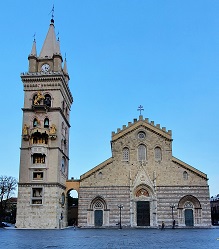 On each side, a lion holds up a tortile column with a plant-motif capital. Above the columns are recesses with statues which include those of the Madonna of the Annunciation, the Archangel Gabriel, and Saints Barbara, Catherine, Peter, Paul and John the Baptist. 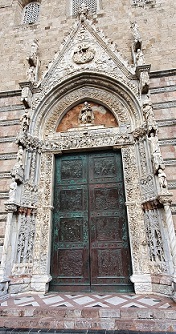 Above the door in a crescent like shape is a statue representing the Madonna enthroned with the Baby Jesus, dating to 1534; in the background is a fresco depicting a choir of angels with musical instrument, from the 19th century. The interior of the Cathedral has three naves, separated by two rows of thirteen columns. These are made of reinforced concrete faced with artificial marble. The columns which have capitals in various styles, culminate in a series of arches. 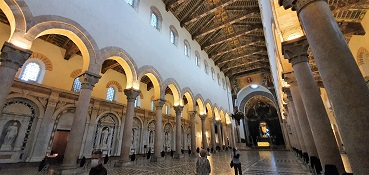 The internal length of the Cathedral is 92 m. Its width, at the transept, is about 40 m. and its height at that point is 30 m. The height of the main nave is 25 m. At the end of each nave is a chapel and altar. The central nave has the main altar.   Both the left and the right nave contain a beautiful chapel and altar. On the left is the original 14th century mosaic which portrays the Virgin Mary holding the Baby Jesus; on the left are St. Agatha and the Archangel Michael; on the right St. Lucy and the Archangel Gabriel; kneeling, below the Archangels’ hands are Queen Eleanor and Queen Elisabeth of Aragon. Below the arch, there are representations of eight virgin Saints. 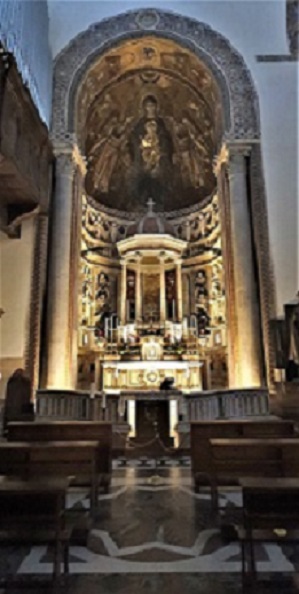  The right apse is decorated with bronze cherubim, a 17th century work by Innocenzo Mangani. The mosaic represents St. John the Evangelist between St. Nicholas and St. Minas, Ludovico King of Aragon and Giovanni, Duke of Randazzo are kneeling in the foreground. Only the lateral, darker parts of the mosaic are original and date from the 14th century, while the central part is a post-earthquake reproduction. The mosaic was reconstructed from traces that survived, Most of the interior was reconstructed in the 20th century, and only a few parts are original. The main apse was recreated based on the original. All of the figures of the apostles, which stand in niches on the walls of the aisle are reproductions as they were destroyed in 1943. 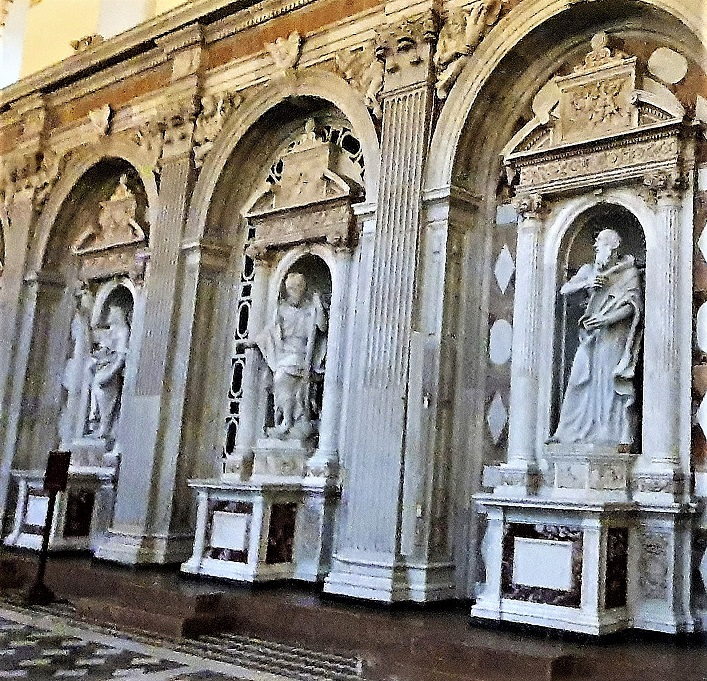 The exception is the statue of John the Baptist by Antonello Gagini, which is the original. Having survived the 1908 earthquake it was unscathed by the fire in 1943: It has undergone restoration since then. Also to survive were several tombs of archbishops. Most of the works of art were destroyed and those seen today are reproductions. The marble floor was created by Giovanni Angelo Montorsoli, a pupil of Michelangelo, in the second half of the 16th century. This is a faithful post-war reproduction of the original one with its beautiful geometrical pattern. The ceilings were also recreated following the 1943 fire. These were made of painted wood by Daniele Schmidt to copy the original ones. 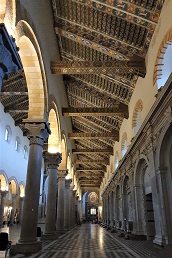 The chandelier hanging from the nave is a reproduction of the one given by the Bourbon King Ferdinand II, in 1847. The chandelier hanging from the nave is a reproduction of the one given by the Bourbon King Ferdinand II, in 1847.The baptismal font is a copy of the antique 14th century one, which ones stood in the church. 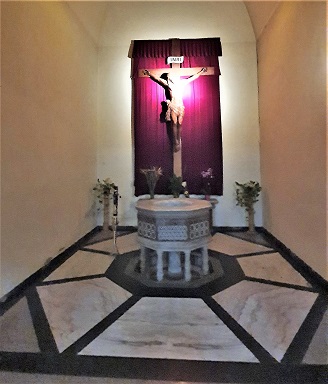 The octagonal shape pulpit, is a faithful copy of the original, attributed to Andrea Calamech, in the 16th century. 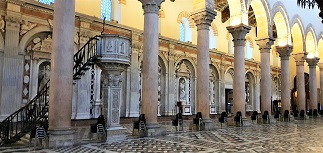 This was badly damaged in the 1908 earthquake and completed destroyed in the Second World War. It has a chalice shape and the pedestal is decorated with floral patterns. The pulpit is decorated with eight bas-reliefs, which depict the theological Virtues, Christ giving a blessing and the four Evangelists. Just outside of the cathedral is the bell tower.  This contains the biggest and most complex mechanical and astronomical clock in the world. Designed by the firm Ungerer of Strasbourg it was inaugurated in 1933 and is the city’s main attraction. Each day at noon, a complex system of counterweights, leverages and gears, determines the movement of the gilded bronze statues located in the façade, a show that lasts for 12 minutes. |
|
|
|
|
|||
All Photographs were taken by and are copyright of Ron Gatepain
| Site Map |